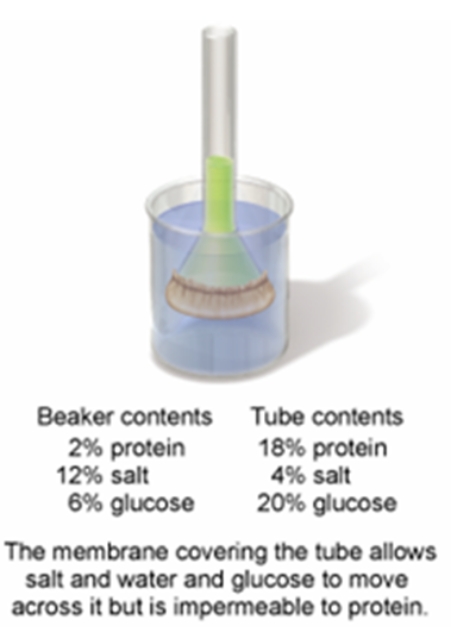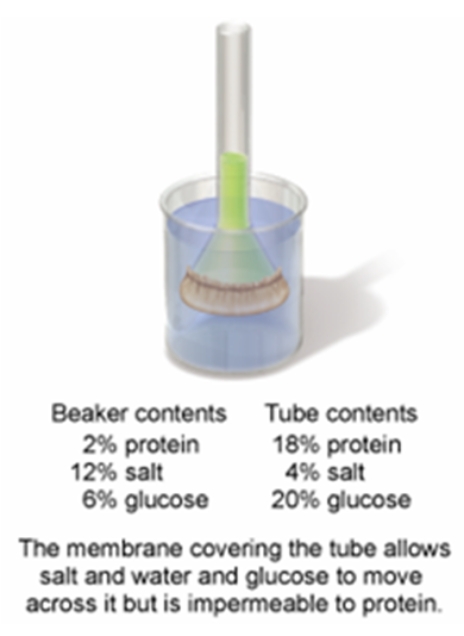A) osmosis
B) facilitated diffusion
C) active transport
D) feedback inhibition
E) phagocytosis
Correct Answer

verified
Correct Answer
verified
Multiple Choice
The second law of thermodynamics states that all energy transformations result in more disordered energy.How can photosynthesis take more disordered carbon dioxide and water and convert them into glucose which is more ordered?
A) living things do not obey the laws of thermodynamics
B) this is an illusion, it only appears that glucose is more ordered
C) photosynthesis is an exception to the second law of thermodynamics
D) solar energy is being added to the reaction to create glucose
E) plants are able to harness entropy and use it to carry out photosynthesis
Correct Answer

verified
Correct Answer
verified
Multiple Choice
When a cell is in a solution where the concentration of solute is the same in the cell as in the solution,the solution is called
A) isotonic.
B) hypertonic.
C) hypotonic.
D) osmotonic.
E) saturated.
Correct Answer

verified
Correct Answer
verified
Multiple Choice
Once the substrate moves into the active site of the enzyme
A) the enzyme breaks the substrate into three products.
B) the two molecules fuse together to form the product.
C) the enzyme alters in shape to more closely fit the substrate.
D) the substrate alters shape to more closely fit the active site.
E) the substrate and enzyme both alter shape to fit together.
Correct Answer

verified
C
Correct Answer
verified
Multiple Choice
Which of the following enables a cell to pick up and concentrate a specific type of molecule?
A) passive transport
B) receptor-mediated endocytosis
C) osmosis
D) exocytosis
E) facilitated diffusion
Correct Answer

verified
Correct Answer
verified
Multiple Choice
Which of the following is NOT an example of osmosis?
A) Salting meat serves as a preservative.
B) Vegetables placed in fresh water firm up.
C) Sugar in coffee dissolves.
D) Strawberries placed in sugar become syrupy.
E) Eating salty popcorn makes people's lips dry.
Correct Answer

verified
Correct Answer
verified
Multiple Choice
Why do metabolic pathways require tens to hundreds of different enzymes?
A) The enzymes are used up after one reaction and the molecules have to undergo multiple rearrangements.
B) The enzyme is deformed by the interaction with the substrate and needs a period of time to return to its original reactive form so many enzymes are needed to keep the pathway going.
C) Each enzyme has a specific substrate and produces a specific product.
D) Multiple enzymes are not required for the pathway but having them speed up the production of the final product.
E) The enzymes are attached to a membrane and cannot move to the location of the new intermediate so having a long line of enzymes to carry out the reaction allows the reaction to occur faster.
Correct Answer

verified
Correct Answer
verified
Multiple Choice
Which form of passive transport allows small molecules,such as oxygen,to cross the cell membrane?
A) diffusion
B) osmosis
C) plasmolysis
D) phagocytosis
E) pinocytosis
Correct Answer

verified
Correct Answer
verified
Multiple Choice
Which of the types of cellular activities listed below would not use ATP?
A) active transport
B) muscular contraction
C) flagella movement
D) passive transport
E) protein synthesis
Correct Answer

verified
Correct Answer
verified
Multiple Choice
Which of the following statements reflects what occurs in the flow of energy conversions through living systems?
A) Chloroplasts convert solar energy to the chemical energy of nutrient molecules.
B) Mitochondria convert ATP molecules into glucose.
C) Chloroplasts produce CO2 and H2O during photosynthesis.
D) Mitochondria capture solar energy and convert it to oxygen.
E) Chloroplasts burn glucose into ATP molecules during cell respiration.
Correct Answer

verified
Correct Answer
verified
Multiple Choice
In the set-up shown in the figure below,which of the following statements would describe what would be observed after 12 hours of time have elapsed? 
A) The level of the solution in the tube would rise because there are now more dissolved solutes present in the beaker than in the tube.
B) The level of the solution in the tube would lower because the glucose and salt would move into the tube.
C) The level of the solution in the tube would rise because there are now more dissolved solutes in the tube than the beaker.
D) The level of the solution would not change as the membrane prohibits any exchange between tube and the beaker.
E) The level of solution in the tubes would see no change because the solute levels are equal on both sides.
Correct Answer

verified
C
Correct Answer
verified
Multiple Choice
In the set-up shown in the figure below,which process allows the water to move across the membrane? 
A) osmosis
B) active transport
C) phagocytosis
D) facilitated diffusion
E) passive transport
Correct Answer

verified
Correct Answer
verified
Multiple Choice
Which of the following is an example of osmosis?
A) Glucose is transported from our blood stream across cell membranes and into the cytoplasm.
B) Sodium is pumped across a cell to increase its concentration on one side of the cell membrane.
C) Cells of our kidneys reabsorb water to prevent it from all leaving through our urine.
D) A broken bottle of perfume is able to be smelled throughout the department store.
E) A bacterium in the blood stream is engulfed by a white blood cell.
Correct Answer

verified
C
Correct Answer
verified
Multiple Choice
The second law of thermodynamics states that all energy transformations result in more disordered energy.How do living organisms,which depend on chemical potential converting to kinetic energy to fuel their function,continue to live?
A) they must constantly take in chemical potential energy for fuel and excrete waste
B) living things do not obey the laws of thermodynamics
C) they must constantly take in chemical potential energy for fuel
D) they excrete the disordered molecules and lose the disordered energy as heat
E) they take the disordered molecules and heat energy and use them to create new fuel
Correct Answer

verified
Correct Answer
verified
Multiple Choice
In feedback inhibition of a metabolic pathway,where does the inhibitor bind?
A) to the enzyme of the first reaction
B) to the substrate of the first reaction
C) to the product of the first reaction
D) to the enzyme of the last reaction
E) to a substrate or the product of the last reaction
Correct Answer

verified
Correct Answer
verified
Multiple Choice
Considering the ATP cycle,which of the following would have the most potential energy to perform work for cell activities?
A) ATP
B) ADP
C) adenosine
D) AMP
E) H+ ions
Correct Answer

verified
Correct Answer
verified
Multiple Choice
Which of the following is not a type of potential energy?
A) the energy in a glucose molecule
B) the energy contained in an rock sitting at the top of a cliff
C) the energy of a ball rolling down a hill
D) the energy contained in a hamburger
E) the energy of a diver standing on a diving board
Correct Answer

verified
Correct Answer
verified
Multiple Choice
Because it is a passive process,which membrane transport process can continue whether the cell is alive or dead?
A) diffusion
B) sodium/potassium pump
C) pinocytosis
D) phagocytosis
E) exocytosis
Correct Answer

verified
Correct Answer
verified
Multiple Choice
Intestinal cells absorb glucose via active transport.What would happen if all the mitochondria within these intestinal cells were destroyed?
A) Glucose absorption would increase.
B) Glucose absorption would decrease.
C) Glucose absorption would stop.
D) Glucose absorption would not be affected.
E) Glucose absorption would be slow at first and then increase.
Correct Answer

verified
Correct Answer
verified
Multiple Choice
Identify which of the following statements is not true.
A) ATP is formed when energy is released during cell respiration.
B) When ATP becomes ADP + P, the amount of energy released is enough for a biological purpose.
C) ATP is comprised of a sugar, base, and two phosphate groups.
D) ATP contains the energy form used for cellular work.
E) ADP is low in potential energy.
Correct Answer

verified
Correct Answer
verified
Showing 1 - 20 of 67
Related Exams